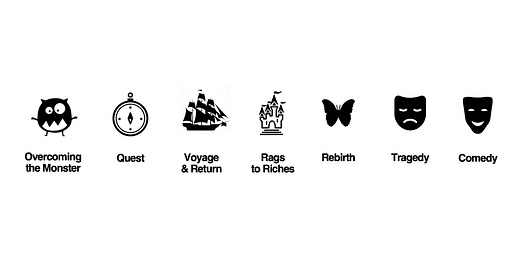A passing comment in a Cannes bar changed my life.
I was about three rosés in at the Carlton lobby bar when a buddy of mine casually tossed off, “You know there are only 7 stories in the world…”
Wait, what?
We were lamenting advertising and dreaming about Hollywood.
This was around 2006.
I’ve been thinking about that 7-story thing ever since.
It became a quest, to borrow from the theory.
Fortunately, the whole thing became clear to me after I stumbled upon an amazing 736-page book called, The 7 Basic Plots: Why We Tell Stories, written by Christopher Booker.
Booker’s theory in its most reduced form is this: Every writer from Shakespeare to Spielberg to Taylor Sheridan bases their narratives on one of seven “basic plots.”
Those plots:
Overcoming the Monster
A protagonist must defeat a powerful antagonistic force that threatens them or their homeland.
(Think: David and Goliath, Dracula and every James Bond film)
The Quest
The protagonist and companions journey to acquire an important object or reach a special location, facing obstacles along the way.
(Think: Lord of the Rings and Raiders of the Lost Ark)
Voyage and Return
The protagonist travels to an unfamiliar world, faces challenges, and returns with experience or wisdom.
(Think: The Odyssey, Alice in Wonderland, Wizard of Oz)
Rags to Riches
The protagonist begins poor or powerless but achieves wealth, success, or love through a journey of personal growth.
(Think: Great Expectations, Cinderella, There Will Be Blood)
Rebirth
The protagonist undergoes a transformation through redemption or spiritual awakening after a period of darkness.
(Think: Lazarus from the Bible, A Christmas Carol, Groundhog Day)
Tragedy
The protagonist's moral failings or fatal flaw leads to their inevitable downfall.
(Think: Oedipus, Macbeth, Sophie’s Choice)
Comedy
A light and humorous story centered on amusing scenarios that typically end happily.
(Think: A Midsummer Night’s Dream, Blazing Saddles, The Office)
As humans, we’re wired for story—neurologically and chemically. Research from Princeton University and neuroscientist Paul Zak shows that storytelling triggers the release of cortisol (for attention), dopamine (for emotional engagement), and oxytocin (for empathy), making stories both powerful and memorable.
With all of this proven theory, I did an experiment. I mapped the 7 Stories to the world’s most valuable brands from the Interbrand Global 100. And wouldn’t you know, the theory held up.
From there I decided to use the 7 Stories in my work.
If I was stuck writing a spot, I would try all 7 until I hit upon a something that worked. Here’s Rebirth at work for Nissan.
If I was reviewing a pitch deck, I would often ask: “What story are we telling?”
I eventually showcased the my 7 Story brand theory at a conference at Yale. You can watch it here.
Eventually, I turned the whole theory into a workshop to help brands with their storytelling.
In fact last week I worked with a brand and the 7 Stories truly helped them unlock a brilliant narrative for their business.
Next up: I’m working on “The 7 Stories for Executive Coaching.”
I’ll keep you posted on the progress.
Meantime, think about what you’re working on.
What’s your story?





I use this in teaching writing and for my strategy work! It’s great.
Love the spot! And, I ordered the book. Thank you for sharing.